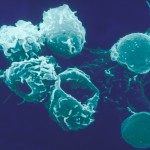Lien vers Pubmed [PMID] – 10940911
Eur. J. Immunol. 2000 Aug;30(8):2201-10
In the mouse, the number and the differentiation potential of thymic migrants remain controversial. A fetal thymic organ culture under limiting dilution conditions allowed us to show a 130-fold increase in the numbers of T cell precursors in the embryonic thymus between days 12 and 14 of gestation. A comparative analysis of the most immature thymocytes at these two stages revealed that: (1) CD44(+)CD25(-) (DN1) thymocytes at 14 days post coitum (dpc) efficiently differentiate into mature T cells both in vivo and in vitro; (2) 12dpc thymocytes exhibit a low frequency of T cell precursors and were unable to generate a detectable progeny after in vivo intrathymic transfer. A 48-h organ culture of 12dpc thymic lobes did neither correct the low frequency of T cell precursors nor the absence of expression of T cell-specific genes observed in 12dpc thymocytes. We thus concluded that a fraction of recent thymic immigrants contribute to the observed properties in DN1 14dpc thymocytes. We show that increasing numbers of T cell precursors migrate to the thymus from 11 to 14 dpc. We propose that the first thymic immigrants do not contribute significantly to T cell generation which depends on the subsequent colonization by cells with a high T cell precursor potential.

